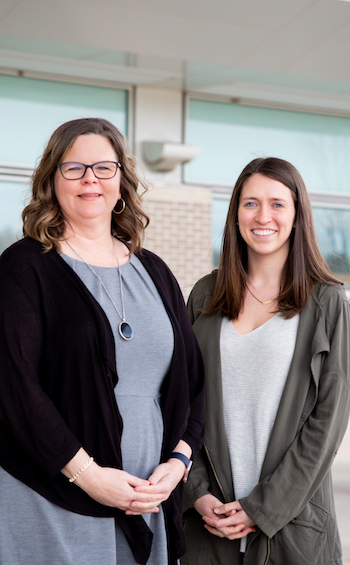Project connects university’s autism experts and graduate students with Gundersen Boscobel Area Hospital and Clinics
As Jessica Muesbeck was working toward her master’s degree in occupational therapy, she was searching for additional opportunities to apply the knowledge she was gaining in the classroom and as a member of Assistant Professor Karla Ausderau’s research lab.

Thanks to guidance from Ausderau, community connections, and support from the School of Education’s Network Fellows program — which connects graduate students to community partners to engage in impactful projects — Muesbeck and the Ausderau Lab were able to begin a collaborative partnership with Gundersen Boscobel Area Hospital and Clinics (GBAHC). The partnership is designed to assist GBAHC in making its health care facilities and emergency department more accessible for children with autism spectrum disorder (ASD) and sensory processing challenges.
Building on this initial work, Muesbeck and Ausderau then received a Baldwin Wisconsin Idea Seed Grant to expand their collaboration to additional rural emergency departments in Wisconsin.
“What really excites me is the chance to work with a rural healthcare facility,” says Muesbeck, who will be graduating in December. “As an OT, we often think of using what we learn in treatment sessions or in schools. But thinking about how to help a child with autism better experience a hospital emergency room gives me a chance to apply what I’m learning in a different type of setting.”
One in 59 children in the U.S. is diagnosed with ASD, and often presents with social-communication deficits, restrictive and repetitive behaviors, and challenges in managing sensory environments. Emergency departments, in particular, present fast-paced, high-stress, and sensory-intensive settings.
Rose Cutting, executive director of Aiming for Acceptance and an autism advocate in southwestern Wisconsin, connected Ausderau with David Hartberg, CEO at GBAHC. Hartberg and his team were looking for ways to make their health care and emergency room settings more comforting and predictable for children with ASD.
In December 2018, the researchers met with a range of stake- holders from GBAHC to learn as much as they could about the facilities and the work being done there. In March 2019, the research team returned to Boscobel, about 75 miles west of Madison, to deliver a presentation to hospital staff about key characteristics of ASD and sensory processing. They went over challenges and opportunities regarding helping children with ASD in emergency room settings, and discussed strategies and adaptions to make the experience better.
“In a rural health care facility, everyone is asked to know a lot on a variety of different topics,” says Hartberg. “This can be very challenging at times, and so you look for content experts who can help. We have great colleagues and resources across the Gundersen Health System, but it’s valuable to have additional support. The relationship we’ve built with UW–Madison is out- standing because they are the content experts who can fill the gaps where we need a little help.”
This summer, the collaborators will develop guidelines, and provide education support, environmental adaptations, and sensory toolboxes for working with children with ASD and sensory processing challenges in the health care setting.
Gundersen Boscobel Area Hospital and Clinics is the pilot partner in this grant-funded initiative, and after outcomes are measured with input from families, community stakeholders, and hospital staff, the goal is to expand this initiative to three additional rural health care emergency rooms.
“Working in partnership with Gundersen Boscobel, our lab will gain important insights into how we can think about better serving children with autism moving forward,” says Ausderau.